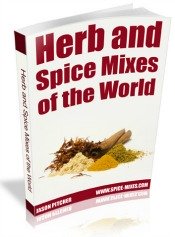Thai Basil Herb - Flavouring and Enhancing Food For Over 5000 Years!
Native to Southeast Asia, Thai basil is extensively used in Thai cooking, whilst here in Europe it's usually the sweet variety that is favoured. This aromatic herb has been grown there for more than 5,000 years!
From there it spread around the world to influence medicine, culture and cuisines as far away as Italy, Mexico and Vietnam.
The word “basil” comes from the Greek word “basileus”, which means king. Appropriately enough, this herb is often referred to as the "King of Herbs!"
There are many varieties and strains, each one favoured by different cultures...
In Asia it's Thai basil with purple stems, mauve flowers, and deep green spear-like leaves that you'll use...
...Whilst sweet basil is a light shade of green, and is known for its wide leaves. This is the type most commonly grown, sold and used in the West.
Varieties of This Tasty Herb
Varieties of Thai Basil Plants...
There are 3 main types used in Asian cooking, in order of popularity...
- Horapa - Thai
- Kraphao - Thai holy
- Maenglak - Thai lemon
Each strain has a unique flavour and each one packed full of essential oils which give each plant their individual aroma, taste and health benefits.
You won't often find these varieties available in your local store so growing from seed may be a good idea. Here are some tips on how to grow it.
If you are interested in the health and well-being uses of this herb, click for more info on the health benefits.
Myths & Traditional Uses For Basil...
In Italy, lovers would wear a sprig in their hair. In Ancient Egypt, it was used in the embalming process, and in Greece, it was a symbol of mourning.
In its native India, it was used to swear an oath in court. In African lore it is said to be a protection against scorpions.
Whilst in various Orthodox churches, pots of the herb are placed below altars and used in holy water preparation.
And legend says, after Christ resurrected, the herb was found growing around his tomb.
Cooking With Thai Basil Herb...
This herb is an important ingredient in Thailand’s green and red curries. These leaves are also served along with the incredibly popular Vietnamese soup known as phở. Chicken or pork dishes are often flavoured with Thai holy basil.
It's often steeped in cream or coconut milk to infuse the liquid with its delicate flavour and aroma, and is often even made into desserts and ice creams. You can even make a healthy, tasty cup of basil tea.
|
Other Herbs You May Enjoy
- The Parsley Plant - The world’s most popular herb!
- Delightful Common Thyme - A staple of Mediterranean diets
- Sage Plant Info - Ornamental, decorative and very tasty!
Return to Basil Herb
Return to Home
Click on the buttons above to follow me on your favourite social media:
by
Jason Pitcher

Sign up to my monthly newsletter and get a
FREE Book!
Click on the buttons above to follow me on your favourite social media:







New! Comments
Have your say about what you just read! Leave me a comment in the box below.